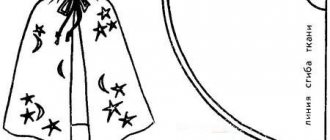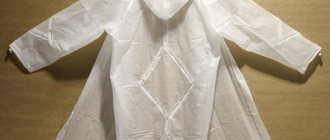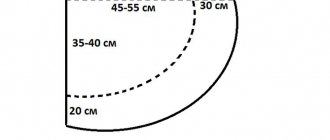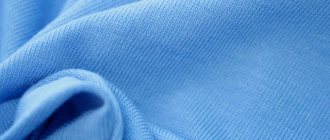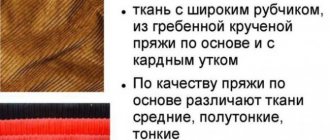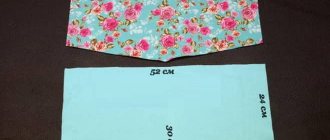The trench coat is stylish and at the same time very versatile and practical item in the wardrobe. The main distinguishing characteristics of this raincoat are the large turn-down double-breasted collar, shoulder straps, cuffs and belt. Also, this coat features two rows of buttons on both fronts.
To sew a trench coat, as a rule, hard waterproof fabrics are used: cotton twill, gabardine and other fabrics with special impregnation.
Made in classic colors (black, white, all shades of beige), the trench coat will look stylish for several seasons, allowing you to create many completely different looks - from elegant to sporty.
In this master class we will sew a trench coat using pattern 113 from Burda 9/2010.
Find your perfect trench coat: 20 trench coat patterns
Preparing to sew a raincoat
First of all, you should choose the fabric that you will use to sew a stylish product. Give preference to dense, wrinkle-resistant material that will reliably protect against the vagaries of nature. If you want to sew a raincoat that you can wear until the cold weather, choose a fabric with a thin layer of synthetic padding as a base. Leather models look very elegant, characterized by unpretentiousness in tailoring. Whatever material you choose, do not forget about the lining fabric, which will give the item a more aesthetic appearance and hide the internal seams.
Before purchasing material, you should decide on the parameters of the product. If you want to sew a long raincoat, take the fabric “with a reserve”, taking into account that the fabric will rise a little due to the stitching. Also, do not forget about the accessories - buttons, snaps, zippers, which should be matched to the color and style of the future raincoat.
The product can be either monochromatic or combining several different colors. The classic model of a raincoat is fitted, with a double-breasted collar, optionally with a hood, belt and two internal pockets.
This is interesting: Raincoat pattern
How to sew a raincoat with your own hands
Modern industry produces a variety of materials with waterproof properties. Such fabrics are used primarily for sewing waterproof sports tourism clothing (tents, awnings, special suits). And also for creating raincoats for everyday wear. Sewing a raincoat with your own hands is quite simple. Such clothes will last a long time, and they are much more convenient to use than an umbrella. Easily fits even into a small bag and does not require much drying space.
instructables.com
Fabric selection
To sew a raincoat, of course, you need water-repellent material. According to its characteristics, this fabric can be classified as a technical material, but it can also be purchased in a regular store. The level of moisture protection is often indicated on the label. If there is an inscription “dry10”, it means that the material holds 10,000 mm/cm² per day. You can also find “breathable” water-repellent fabrics on the counters. Such a raincoat will not allow the greenhouse effect, so it will be as comfortable as possible at any time of the year. The presence of the “upward arrow” symbol indicates the breathability of the fabric.
We are talking about everyday clothes, and not about a special suit for multi-day hikes; you can choose a simpler material - calendered nylon or lavsan. It is easy to create a raincoat using the old method from cotton fabric, soaking it yourself with a water-repellent solution. Another technology, more modern, is sewing a raincoat from thick IKEA bags. Other similar material is also used as a substitute.
sncmedia.ru
IKEA bags are very durable and waterproof, and can also be sewn. They are ideal for a raincoat due to their characteristics.
popcornnews.ru
What to consider when sewing a raincoat from bags
- Draw pattern lines along the fabric texture (stripes). This technique will make the product less brittle.
- Try to form fragments of the product in such a way that the inside and outside textures match. Sometimes it's hard to tell which side of the bag is which, so pay attention to the texture and color.
- Make sure all seams are on the inside of the jacket.
- Cut out identical pieces by folding the material either in half or just together. This will save a lot of time.
- When ripping bags, use scissors or a utility knife. Do not cut them into pieces, otherwise the fabric will begin to fray and additional time and money will be required for processing.
Materials and tools
- Several IKEA bags (4-5 pcs).
- Sewing machine.
- Scissors.
- Needles.
Progress
- Print or draw a pattern.
- This pattern is suitable for creating a medium sized women's raincoat.
- Cut out all the pieces.
- Cut out four pieces for the sleeves. Separate the two bags. Do not touch the hem (the part where the handles are inserted). One bag should be enough for two sleeves.
- Divide the other bag without folding. It will be used for two pieces of the back.
- In the next bag you open, do not touch the hem either. This will save you from having to finish the bottom edge later. If the handles are in the way, carefully tear them out and stitch the torn areas. From the resulting piece, cut out two front pieces.
- Cut two pieces for the hood using leftover pieces or a new bag.
- Connect the sleeves.
- Take two sleeve pieces and sew along the longer edge. Repeat this for the other sleeve. When unfolded, there should be two pieces that match Figure A.
- Then sew along the other edge as in picture B.
- Sew the back.
- Connect the two pieces and stitch along the long edge.
- Connect the back to the front parts.
- Sew the shorter vertical edge of the front to the edge of the back, right first. Repeat this step with the other front piece on the left.
- Sew on the sleeves.
- Secure the inverted sleeves with needles on the wrong side of the product, and then stitch. Do not sew the shoulder edges all the way. Later they will be sewn to the hood.
- Form a hood and sew to the base of the product.
- Then use a hem stitch along the edge of the hole.
- Sew the hood to the base.
- Finish all exposed edges of the piece.
- Cut two pieces from the handles of the bag (10 cm each) and sew them into the seams on the sides, thereby forming loops for the belt.
- To make the belt, sew two handles of the bag. Light with fire or stitch the ends so that they do not fray.
- Form two more long strips of handles and sew them along the bottom edge of the raincoat to protect that edge from quickly fraying.
- The raincoat is ready.
02
instructables.com
instructables.com
instructables.com
fashionelement.ru
How is the pattern made?
A women's raincoat is made according to a pattern, before making which you will need to take your own measurements: shoulder width, chest volume, length of sleeves and the length of the product itself. Then, using the measurements, you should design the following details on paper:
- back – 2 pcs;
- sleeves – 2 pcs;
- front - 2 pcs;
- Collar bead – 2 pcs;
- front pick-up – 2 pcs;
- valves for pockets – 3 pcs.
The number of collar details depends on the chosen cut, and if you choose a style with a hood, then this element is usually missing.
If you have any difficulties making a pattern, there are plenty of professional video tutorials online for beginners, which show you the entire process of sewing a product step by step. A high-quality pattern is the key to a beautiful and perfectly fitting product. It is better to measure the parameters of your figure several times than to receive a product that is too large or, conversely, small.
When the pattern is completely ready, you can start sewing the raincoat, having prepared the following tools in advance: tailor's scissors, threads to match the fabric, needles, pencil or chalk for marking.
DIY raincoat
It happens that it is quite warm outside, but it rains all day. Often bad weather drags on for several days. This is not a reason to deprive your child of a walk. You can buy a children's umbrella, but we recommend sewing a raincoat for your little one with your own hands.
To sew a children's raincoat with our own hands we will need:
- raincoat or mixed fabric;
- braid to match the fabric (or contrasting color);
- elastic band;
- 2 large and 2 medium buttons are identical in appearance;
- sewing supplies;
- sewing machine.
Children's raincoat pattern
The raincoat pattern is very simple. To build it, we need one measure - the child must stand with his arms extended to the sides. We measure the distance from the base of the middle finger of one hand to the base of the finger of the other hand.
We build a square on the fabric, which is diagonally equal to the resulting distance. Along the marked diagonal line we make a cut for the neck and make a small cut along the perpendicular line.
From the raincoat fabric folded in half, we cut out a rectangle for the hood, 30 cm high, with a width of half - 27 - 28 cm.
How to sew a raincoat for a child?
- We turn the edges 1.5 cm, baste and sew a neat stitch.
- We fold the hood on three sides in order to subsequently insert an elastic band, and make stitching. We connect the hood along the bottom edge with the raincoat.
- In the center of both sides of the square we sew middle buttons, on the other side we make loops. This way the raincoat-cape is connected at the sides.
- From the same waterproof fabric included with a raincoat for a child, you can sew a skirt with your own hands. To do this, cut out a rectangle of the required length. We make a back seam and turn the bottom. We make lines in the upper part and insert elastic in 2-3 rows.
- Sew large buttons on the sides in the waist area. By fastening the loops from the top of the raincoat, we get a solid product.
A comfortable and beautiful raincoat for a young fashionista is ready!
Source: https://womanadvice.ru/dozhdevik-svoimi-rukami
Step-by-step instructions on how to sew a raincoat quickly and easily
- Transfer the pattern to the fabric, carefully cut out all the parts from the fabric. Be very careful not to miss the slightest dart.
- Sew all the prefabricated parts of the sleeve, front, and back using a sewing machine. Then all seams should be carefully straightened and ironed.
- Make holes for buttons or think about the location of the buttons. If you plan to use a zipper as a closure, skip this step.
- If you are sewing an autumn raincoat with pockets, sew the inner parts to the front of the product.
- Based on the measurements, sew burlap sleeves from the lining fabric and carefully sew them on the wrong side. At this stage, it is worth considering what kind of sleeves you want - classic or with cuffs.
- Connect all the pieces using shoulder and side seams.
- The collar, hood and sleeves should be sewn in last, when the base of the item is completely ready.
- Sew the lining fabric to the main part of the product and connect it to the sleeves.
- If you plan to focus on the waist, sew a belt.
This is the easiest and most affordable way to sew a raincoat with your own hands. There are many other styles - loose, asymmetrical length, short sleeves. If desired, you can further decorate the product with embroidery, ornaments or sequins. A handmade raincoat will not only become comfortable clothing for every day, but will also allow you to show your individuality and refined taste.
Cloak Cloak pattern Outerwear Sewing Needlework Handmade
Related Posts
Do-it-yourself raincoat: cutting options – Big Campaign
If you have at least minimal sewing skills, then making a raincoat for yourself or a loved one will not be difficult. Carrying an umbrella with you is not always convenient, but a raincoat, sewn with your own hands, can save you from bad weather and, moreover, will not take up much space in your purse.
Raincoat cut options
Today, raincoats of various colors, textures and models are in fashion. A raincoat, poncho, cape, trench coat, mac are options that can be taken as a basis. Decorate it with some decorative elements and your individual item will be the envy of everyone.
The simplest cut option is a poncho raincoat, which can be cut in two ways.
- A circle of fabric with a diameter equal to the measurement from wrist to wrist across the neck of a child or adult.
- Based on a square in which the side seams are drawn into the sleeves.
The poncho can be fastened with a zipper, buttons, or a belt. Or it can simply be put on over the head. The length may also vary.
What will you need for work?
Having decided on the cut, the first thing to do is choose the appropriate material. Here is where to roam:
- polyethylene - a DIY raincoat made of polyethylene will be an excellent option for walks in the forest or in the park. It is distinguished by its lightness; dense polyethylene is easy to work with. The material can be taken from ordinary thick bags;
- rubberized material - a universal option for outdoor activities, fishing, city walks;
- bologna - lightweight windbreakers, raincoats and raincoats are made from bologna fabric. The material is durable and lightweight, but does not “breathe”;
- Vinyl is a durable material, does not allow moisture to pass through, and is resistant to mechanical damage. You can use it to make a raincoat of any model, color, in combination with or without lining;
- rubber - the material is quite dense and suitable for off-season use. Usually such raincoats are sewn with a lining. In rubber clothing you will be saved not only from the rain, but also from the wind;
- Nylon is a universal material for raincoats of different models and purposes. You can wear a nylon raincoat to pick mushrooms or to a business meeting;
- membrane - the material does not allow moisture to pass inside, but at the same time allows the body to “breathe”. These raincoats look stylish, have an unlimited range of colors and a variety of styles. Membrane fabric is especially suitable for children, because... babies are very active and it is important that there is good air exchange under clothes;
- silicone - a durable and moisture-resistant raincoat made of silicone has one drawback - it does not allow air to pass through. Therefore, if you sew clothes from such material, then only with a loose cut;
- varnished fabric - coats with varnish coating look fashionable and unusual. Suitable for girls who want to create a bright image.
To make a raincoat with your own hands you will need vinyl
For creative individuals, you can offer a do-it-yourself raincoat made from bags. These can be waste products, milk containers, etc.
When the material is selected, you need to prepare other tools:
- sewing machine and needle;
- scissors;
- threads;
- tape measure;
- pins;
- clasp;
- marker or fabric chalk;
- decorative elements.
Think over the model of the raincoat and its decoration. If you plan to tighten it at the waist and in the hood, you will need a drawstring or braid.
Basics and tricks for cutting a raincoat with your own hands, patterns
There are no special tricks to sewing a raincoat. The only points worth considering are the processing of the bottom and cuts. The easiest option is to cover all cut lines with bias tape or tape.
There are various color options on sale that can be matched to the material or in contrast to it. If you are sewing a raincoat from raincoat fabric, the braid can be cut from the same fabric. If you are processing the front shelves and hood, the fabric or braid needs to be folded in half.
You don’t have to process the bottom of the raincoat at all, but simply turn it up a couple of turns and stitch it.
On thick fabrics, there may be a problem with punching through loops, so the best option would be a zipper or sew-on buttons.
For those who do not want to bother with patterns, there is a simple option for sewing a raincoat - using an existing item. In this way you can sew a raincoat-poncho.
All you need to do is place the jacket on a piece of fabric, take the necessary measurements and cut holes in the right places.
For tourists, you can sew a raincoat for a backpack with your own hands, then all the necessary things will remain dry. Below are options for patterns of raincoats of various models.
Straight cut polyethylene raincoat
Straight cut polyethylene raincoat
Cape-cloak with hood
Cape-cloak with hood
Raincoat-poncho without sewing
Raincoat-poncho without sewing
Sewing a raincoat with your own hands
The simplest option for sewing a raincoat is a polyethylene poncho model. The material consumption in this case will not exceed 2 m, so the result will be a rather economical thing. The length is measured as follows, taking into account the width and length. When the first indicator is greater than the second, then 2 lengths will be needed, plus 20 cm for the notch for the neck and processing the bottom.
- Find the neck circumference and radius.
- The radius is added to the length of the cloak.
- The material is laid out on a flat surface and leveled well.
- The middle of the edge is located and a dot is placed with a marker.
- A semicircle is drawn with the center at the marked point.
- For the neck, a perpendicular to the edge is drawn from the mark, on which the radius of the recess is marked.
- A circle is drawn and cut out.
If you choose the option with a hood, you can make it from leftover material and cut it out of a square measuring 25x25 cm.
When assembling the raincoat, the front edge of the hood can be immediately hemmed, folded in half, or treated with braid. The bottom of the raincoat is processed in the same way. The lower edge of the hood is aligned with the neckline and pinned. At this stage, it is better to try on the poncho and adjust where necessary. If everything is in order, the hood is attached.
If a version of a raincoat with a fastener is made, then from the front from the neck to the outer edge the material is cut along a straight line. On both sides you need to sew a separate zipper or buttons.
Decorative elements for a raincoat
An ordinary raincoat without decoration looks boring. In order to add some zest to it, you can come up with various decorative elements. This could be contrasting fittings.
Fabric stores have a large selection of thermal images and rhinestones. But, this option is only possible for raincoats made of fabric, because... The oilcloth will simply melt from the heat. You can come up with a version of a raincoat made from combined materials.
For example, combine raincoat fabric and polyethylene.
How to sew a children's raincoat: the basics of cutting and sewing tricks:
“There is no bad weather” - each of us has heard this phrase. And even a rainy day cannot become an obstacle to walking with your child if, in addition to rubber boots, your child’s wardrobe includes a children’s raincoat.
No, we are not talking about this polyethylene miracle of production, which is more reminiscent of a uniform in the exclusion zone. Such a thing is repellent not only in appearance, but also in practice it turns out to be not very convenient.
But if you sew a children's raincoat from raincoat fabric with a beautiful print that the child can choose, then, of course, the child will wear such a thing with pleasure. A thoughtful cut and fasteners will make the item comfortable.
Selection of materials
To sew a high-quality children's raincoat that will really protect from rain, you should take water-repellent raincoat fabric with a polymer coating on the reverse side of the fabric. You can also take raincoat material with a varnish coating.
In the first case, the item will be very thin, and it can be worn directly over a winter jacket. It can be easily folded into a little bag and will not take up much space in your purse.
In the case of patent fabric, the raincoat will be voluminous, and such a thing is more suitable for wearing over a sweater and jacket on a rainy day instead of a windbreaker.
Also, the work will require buttons and decorative buttons if you are planning a model with a clasp. A cord in the hood with tips and fasteners would be a good idea. Naturally, the product should be sewn on a sewing machine, and all cuts should be processed either with satin bias tape or with an overlocker.
Cut options
A children's raincoat can be cut in two ways. This can be simply a circle of fabric with a diameter equal to the measurement from wrist to wrist across the baby's neck. A neck is cut out in the center and a cut is made from the center to the outer border of the circle. This creates a one-piece back and two shelves. All that remains is to make the hood.
Its pattern is made on the basis of two squares with a rounded corner at the back of the head and a rear middle seam slightly shifted towards making the piece smaller. The length of the bottom of the hood should be equal to the length of the neckline. Here you should slightly raise the edge of the part at the back of the head, by about 2 cm.
If the raincoat is without a fastener, the front flap is not cut, and the neck is cut out to a size slightly larger than the circumference of the head.
The pattern of a children's raincoat can also be made on the basis of a square, in which the side seams appear, turning into the sleeves. Here, too, a neckline is cut out in the middle, and the front shelf is divided in half. With this cut, there will be no seams on the shoulders either, but this option must have a fastener.
To beautifully design the cuffs, the fabric is either folded and adjusted, putting additional length into the part when cutting, or a strip of fabric folded in half is sewn on.
Tricks of tailoring
There are no special tricks in how to sew a children's raincoat, but here you should know how to design the bottom of the product, how to close the sections of the shelves and the hood.
One of the simplest options for processing the hem of a round raincoat is to process it with bias tape, which can be cut from the same raincoat fabric.
In the case of front shelves and hoods, it is better to use a strip of fabric folded in half and sew it around the entire perimeter. In this case, the bottom of the product should simply be tucked and stitched.
It is very difficult to punch through loops on such fabric, and therefore the best fastening option would be sew-on buttons and decorative buttons on the front side.
How to sew a raincoat with your own hands
Modern industry produces a variety of materials with waterproof properties. Such fabrics are used primarily for sewing waterproof sports tourism clothing (tents, awnings, special suits).
And also for creating raincoats for everyday wear. Sewing a raincoat with your own hands is quite simple. Such clothes will last a long time, and they are much more convenient to use than an umbrella.
Easily fits even into a small bag and does not require much drying space.
instructables.com
Fabric selection
To sew a raincoat, of course, you need water-repellent material. According to its characteristics, this fabric can be classified as a technical material, but it can also be purchased in a regular store. The level of moisture protection is often indicated on the label.
If there is an inscription “dry10”, it means that the material holds 10,000 mm/cm² per day. You can also find “breathable” water-repellent fabrics on the counters. Such a raincoat will not allow the greenhouse effect, so it will be as comfortable as possible at any time of the year.
The presence of the “upward arrow” symbol indicates the breathability of the fabric.
We are talking about everyday clothes, and not about a special suit for multi-day hikes; you can choose a simpler material - calendered nylon or lavsan.
It is easy to create a raincoat using the old method from cotton fabric, soaking it yourself with a water-repellent solution. Another technology, more modern, is sewing a raincoat from thick IKEA bags.
Source: https://bo-volna.ru/pohod/dozhdevik-svoimi-rukami-varianty-kroya.html
Fashionable women's raincoats for spring and autumn
Raincoats almost never go out of style and this season is no exception. The vast majority of fashion houses presented a wide variety of models in their ready-to-wear collections. When studying fashion trends, it is worth immediately noting that a classic raincoat is always relevant.
As for styles and lengths, fashion designers advise paying attention to double-breasted styles of classic cut and loose models; the length can be very different, from short raincoats like a parka jacket to very long maxis. As you can see in the photo, every fashionista can choose a raincoat according to her taste, figure and preferred style.
Lovers of feminine romantic style also have something to choose from. Many collections feature models with a cut-off waist and a wide bottom. Length – up to or just below the knee and maxi. The color of a raincoat in modern fashion is the personal preference of every woman.
You can safely choose fabric in bright colors or printed material in the online store. For classics, it is recommended to give preference to light shades from milky to light beige and coffee. Many fashion designers presented maxi raincoats in dark colors and black.
Sewing a raincoat - stages and nuances
The pattern of a medium-length double-breasted raincoat with an English collar and welt pockets with flaps consists of:
- Back – 2 parts;
- Front – 2 parts;
- Sleeves – 2 parts each;
- Collar – 6 parts;
- Front trim – 2 parts;
- Collar trim – 2 parts;
- Flaps for pockets – 2 parts;
- Knee strap – 1 piece.
The photo shows a diagram for constructing a pattern, which can be adjusted according to dimensional data and individual characteristics of the figure. When preparing for work and cutting, you need to take into account that you will also need lining fabric and duplicating material for the front and collar hems. If the main fabric is soft, then you can additionally duplicate the upper part of the sleeve and back.
Stages of work:
- Machine stitch all the prefabricated parts - back, sleeves, collar;
- Sew pocket flaps into the front details;
- Sew burlap pockets from lining fabric;
- Insert burlap through the slit with the wrong side facing out and sew it in from the wrong side of the front;
- Sew, connecting the right sides of the hem to the front parts;
- Connect the shoulder seams, then the side seams;
- Sew in sleeves and collar;
- Sew lining fabric.
How to sew a raincoat with a hood (pattern): choosing a style and fabric
206 Article author: Reading time: 21 min.
A raincoat is a convenient and practical item that protects from bad weather. Put in your purse in advance, it will save you from both a small rain and a big downpour. There is no doubt about the demand for this type of clothing, since it is much more convenient than an umbrella.
Differences between a raincoat
Unlike other types of clothing, you can sew such an irreplaceable item in five minutes using scrap materials with your own hands. Special patterns are not required for this. Particular attention should be paid to the choice of fabric, as it must be waterproof. In addition, compared to other raincoats, the raincoat is very compact and does not take up much space.
Choice of style and fabric
To sew a raincoat for a woman, waterproof and water-repellent fabric is used. It can be bought both in specialized construction departments and in sewing stores. It is necessary to check with the seller the level of moisture protection and breathability of the fabric.
Such fabrics are used to make sportswear or travel accessories such as tents, awnings or special suits. Since this item of clothing is not designed for constant wear, it is better to resort to cheaper materials, such as lavsan or ordinary polyethylene fabric.
A raincoat of average size requires about 2 meters of material.
Important! There are two styles of raincoats. This is a raincoat made from two squares or a semicircular raincoat. Raincoats can be different in length and width. It all depends on personal preference.
Wide raincoats are convenient, under which you can hide a bag or backpack. For sewing, you may need a zipper and other accessories. Many craftsmen have learned to sew raincoats from thick, comfortable bags from IKEA.
Taking measurements
You can sew a waterproof raincoat yourself, following the tips and recommendations of experienced craftsmen. An important measure is the length of the product, which is chosen depending on height and personal preferences. You can take a measuring tape and use it to measure the length of other types of outerwear and choose the best one. Usually they prefer to make long raincoats in order to protect the body as much as possible from moisture.
For example, a semicircular raincoat will require 2 lengths. You need to add about 20 cm to the recess for the neck and processing the bottom of the product. Also, if necessary, you need to measure your arm length and neck circumference. In more complex models, hip and chest girth may also be required. Here we look at the simplest, quick options. Loose raincoats without patterns can be sewn for the whole family.
Raincoat pattern
In order to get started, you need to prepare the necessary materials: a piece of special fabric, chalk or soap, a measuring tape, a large ruler, scissors, a needle and thread and other accessories. First you need to draw a pattern. Even a person who is far from design can draw it.
Raincoat without pattern
A rectangle 180 cm long and 150 cm wide can be drawn directly on the fabric. It needs to be cut out, folded in four layers and the required shape drawn by eye. Then, connecting two points along a rounded line, cut out a hole for the neck and sleeve. The shelf is cut in half.
Raincoat pattern 2
Attention! To create a hood pattern, cut out two squares with sides of 40 centimeters each. You can carry out constructions on paper or oilcloth. You can even connect the pattern with tape and try it on. If you don’t like something during the fitting process, it is better to make changes immediately before sewing the main parts.
Raincoat pattern 3
You can make a raincoat like a cape. The fabric is folded diagonally and a semicircle is built on it. Its radius should be equal to the length of the arm. Then the neckline is cut out and a cut is made in the front.
Raincoat pattern 4
Raincoat pattern 4
Hood pattern
The hood is cut out on a separate piece from the remaining material. The advantage of a raincoat in the form of a stole is obvious. This option is suitable for those who do not have a sewing machine. This product is made without seams, and the craftsman does not have to worry about connecting them.
If you want to create something unusual or designer, then it is always better to use ready-made patterns. It's also quite easy to trace around an existing rain cover and make a new one the same.
There is a way to make a raincoat strictly according to your figure. To do this, take your favorite long-sleeved sweater. Next, place it on a sheet of paper folded in half and outline the edges in the shape of a semicircle with a margin. From the resulting edge to the end of the sleeve there should be approximately 10 cm on each side. From the bottom of the sweater to the edge of the paper, the required margin should be at least 20 cm, depending on the desired length of the product.
In the part where there was a neckline on the blouse, we draw a notch for the neck. We measure the recesses for the arms strictly along the sleeve. We place it on the edge of the paper and, at the location of the shoulder, begin to cut off a round hole slightly larger than the neck. Then we cut the paper from the neck to the base on one side only. Cut out one sleeve from the rectangle. The hood can also be outlined according to an existing item.
Stages of work
The sewing process proceeds in the following sequence:
- Connecting the side seams of the resulting parts using a sewing machine or manually. Before stitching, the parts can be pinned together. For greater strength, they are reinforced with bias tape.
- Sewing on the hood. To do this, you need to attach it to the neck. The length of the neckline should match the length of the bottom edge of the hood. It is recommended to immediately hem the front edge of the hood by folding the fabric inside out twice.
- Processing with bias tape on sleeves, hem, edges and hood. This is done both for beauty and to give strength to the product. You can simply fold the edge and sew it on a machine. In quick-fix products, processing may not be carried out at all.
- The choice of material and manufacturing technology for fasteners, if any. These can be ties, buttons, Velcro or snaps. It all depends on the personal preferences of the master. To ensure that the fastener stays on the polyethylene, it is recommended to place a transparent button under it.
- Decoration of the product. The raincoat can be decorated with rhinestones, appliqué, or interesting designs can be painted with indelible paint.
Reference! There are a large number of hood styles. For example, it can be on a stand or removable. Buttons, zippers or Velcro are used as fasteners. The upper cut is decorated with a drawstring or decorative elements.
You can sew a raincoat yourself very quickly. The main thing is to choose a good waterproof fabric and choose the right length of the product. With a little imagination, a raincoat can become not only useful, but also an elegant wardrobe item.
Did you like the article? Share it What is your assessment of this material? Found a mistake? Select it and press Ctrl + Enter. We'll fix everything! Author of the article: We strive to be the first Ask a question to the author
tkaner.com
